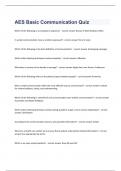Summary
summary pathology 2nd year biomedical sciences part 2
- Course
- Institution
This is an English summary of pathology partial exam 2, given in second year biomedical sciences at vrije universiteit Amsterdam. My combined grade was 8 (1st exam 8.3, 2nd exam 7.7). The summary is based on lecture notes made in 2023.
[Show more]












